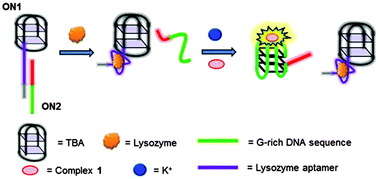A luminescent G-quadruplex-selective iridium(iii) complex for the label-free detection of lysozyme†
Abstract
A novel Ir(III) complex 1 displays high selectivity for the G-quadruplex, and was used to establish a label-free G-quadruplex-based detection platform for lysozyme in buffer. In this study, we employed a special feature of most G-quadruplex probes that they do not respond towards the TBA G-quadruplex. A duplex DNA with a TBA G-quadruplex tail was designed for the detection of lysozyme. The presence of lysozyme will induce duplex dissociation and release the hybridized c-kit87 G-quadruplex, which would be recognized by the Ir(III) complex to generate a strong luminescence response. Common duplex DNA designs lacking a TBA G-quadruplex tail typically contain long complementary DNA regions that may be too stable to be dissociated, thus decreasing sensitivity. We anticipate that the presence of a TBA tail in the DNA duplex may destabilize the duplex structure, allowing the aptamer to be more easily dissociated and bind to the lysozyme, thereby increasing the sensitivity of the lysozyme detection platform. To our knowledge, this is the first example of the use of the TBA G-quadruplex to improve sensitivity through fine-tuning duplex stability. We believe that this approach may be further employed in sensing platforms for other targets. This assay exhibited a linear response for lysozyme within the concentration range of 2–50 nM (R2 = 0.9904), and the limit of detection for lysozyme was 2 nM. Moreover, this platform exhibited a potential use for biological sample analysis.

- This article is part of the themed collection: JMC B Editor’s choice web collection: ‘‘seeing the unseen updated: advances in biosensing’’

 Please wait while we load your content...
Please wait while we load your content...